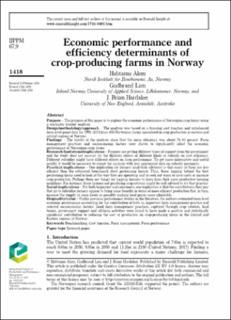Economic performance and efficiency determinants of crop-producing farms in Norway
Peer reviewed, Journal article
Published version
Permanent lenke
https://hdl.handle.net/11250/2649120Utgivelsesdato
2018Metadata
Vis full innførselSamlinger
Originalversjon
International Journal of Productivity and Performance Management. 2018, 67 (9), 1418-1434. 10.1108/IJPPM-01-2018-0026Sammendrag
Purpose – The purpose of this paper is to explore the economic performance of Norwegian crop farms using a stochastic frontier analysis. Design/methodology/approach – The analysis was based on a translog cost function and unbalanced farm-level panel data for 1991–2013 from 455 Norwegian farms specialized in crop production in eastern and central regions of Norway. Findings – The results of the analysis show that the mean efficiency was about 78–81 percent. Farm management practices and socioeconomic factors were shown to significantly affect the economic performance of Norwegian crop farms. Research limitations/implications – Farmers are getting different types of support from the government and the study does not account for the different effects of different kinds of subsidy on cost efficiency. Different subsidies might have different effects on farm performance. To get more informative and useful results, it would be necessary to repeat the analysis with less aggregated data on subsidy payments. Practical implications – One implication for farmers (and their advisers) is that many of them are less efficient than the estimated benchmark (best performing farms). Thus, those lagging behind the best performing farms need to look at the way they are operating and to seek out ways to save costs or increase crop production. Perhaps there are things for lagging farmers to learn from their more productive farming neighbors. For instance, those farmers not practicing crop rotation might be well advised to try that practice. Social implications – For both taxpayers and consumers, one implication is that the contributions they pay that go to subsidize farmers appear to bring some benefits in terms of more efficient production that, in turn, increase the supply of some foods so possibly making food prices more affordable. Originality/value – Unlike previous performance studies in the literature, the authors estimated farm-level economic performance accounting for the contribution of both an important farm management practice and selected socioeconomic factors. Good farm management practices, captured through crop rotation, land tenure, government support and off-farm activities were found to have made a positive and statistically significant contribution to reducing the cost of production on crop-producing farms in the Central and Eastern regions of Norway. Economic performance and efficiency determinants of crop-producing farms in Norway
Beskrivelse
© Habtamu Alem, Gudbrand Lien and J. Brian Hardaker. Published by Emerald Publishing Limited. This article is published under the Creative Commons Attribution (CC BY 4.0) licence. Anyone may reproduce, distribute, translate and create derivative works of this article (for both commercial and non-commercial purposes), subject to full attribution to the original publication and authors. The full terms of this licence may be seen at http://creativecommons.org/licences/by/4.0/legalcode

